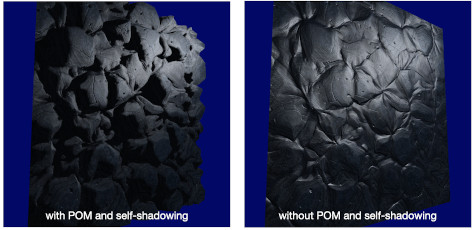Normal mapping is a technique aims to fake a high-accuracy surface on a low-accuracy mesh. It uses a 2D texture (a lookup table) to record surface normals for a mesh. Each point on the surface of the mesh has a corresponding normal in the table. When computing the color for a fragment, we use the normal from the table instead of the interpolated vertex normal. As a result, we get a fake smooth surface with relatively low cost.
The MIT License (MIT)
Copyright (c) 2021, Jiang Ye
Permission is hereby granted, free of charge, to any person obtaining a copy of this software and associated documentation files (the "Software"), to deal in the Software without restriction, including without limitation the rights to use, copy, modify, merge, publish, distribute, sublicense, and/or sell copies of the Software, and to permit persons to whom the Software is furnished to do so, subject to the following conditions:
The above copyright notice and this permission notice shall be included in all copies or substantial portions of the Software.
THE SOFTWARE IS PROVIDED "AS IS", WITHOUT WARRANTY OF ANY KIND, EXPRESS OR IMPLIED, INCLUDING BUT NOT LIMITED TO THE WARRANTIES OF MERCHANTABILITY, FITNESS FOR A PARTICULAR PURPOSE AND NONINFRINGEMENT. IN NO EVENT SHALL THE AUTHORS OR COPYRIGHT HOLDERS BE LIABLE FOR ANY CLAIM, DAMAGES OR OTHER LIABILITY, WHETHER IN AN ACTION OF CONTRACT, TORT OR OTHERWISE, ARISING FROM, OUT OF OR IN CONNECTION WITH THE SOFTWARE OR THE USE OR OTHER DEALINGS IN THE SOFTWARE.
Normal mapping with parallax occlusion mapping and self-shadowing.
As shown in the image, we can obtain some faked stereoscopic effect with POM and self-shadowing.
I have used the following code to compute normals:
normal = texture(normalMap, TexCoords).rgb;
normal = normalize(normal * 2.0 - 1.0);
and it produced an incorrect result. It ignored the fact that normal maps are defined in tangent space. Before using, we should transform them from tangent space to world space.
Check this article to find more information about normal mapping and tangent space. The corresponding code for computing normals can be found here.
In the mentioned article, they use the following code to compute normals in fragment shader.
// from https://github.com/JoeyDeVries/LearnOpenGL
vec3 getNormalFromMap()
{
vec3 tangentNormal = texture(texNormal, uv).xyz * 2.0 - 1.0;
vec3 Q1 = dFdx(worldPos);
vec3 Q2 = dFdy(worldPos);
vec2 st1 = dFdx(uv);
vec2 st2 = dFdy(uv);
vec3 n = normalize(worldN);
vec3 t = normalize(Q1*st2.t - Q2*st1.t);
vec3 b = -normalize(cross(n, t));
mat3 tbn = mat3(t, b, n);
return normalize(tbn * tangentNormal);
}
Each component of a normal which is sampled from a normal map should be transform to [-1, 1] before being used.
dFdx(.) and dFdy(.) are GLSL functions which can only be used in fragment shader.
For a certain variable p at fragment (x, y) in the window space,
dFdx(p(x, y)) returns p(x+1, y) - p(x, y),
and dFdy(p(x, y)) returns p(x, y+1) - p(x, y).
This makes Q1, Q2 be the two edges and st1, st2 be the difference of the texture coordinate in the mentioned article.
The code for computing tangent vector t is based on the following fact:
Finally, tbn * tangentNormal transforms the normal from tangent space to world (or model) space.
When computing specular, using dot(H, N) instead of dot(R, V) can obtain better result.
H is called halfway vector and H = normalize(L + V).
Here, N, R, V, L denotes normal, reflect, view and light vector, respectively.
Aims to generate faked stereoscopic effect without adding extra vertices.
You can refer to this article to get more details, and here is the original code.
Note that if you want to compute TBN matrix in fragment shader, you can try the following code:
mat3 computeTBN(vec2 tempUv){
vec3 Q1 = dFdx(worldPos);
vec3 Q2 = dFdy(worldPos);
vec2 st1 = dFdx(tempUv);
vec2 st2 = dFdy(tempUv);
vec3 n = normalize(worldN);
vec3 t = normalize(Q1*st2.t - Q2*st1.t);
// in the normal mapping tutorial,
// they use vec3 b = -normalize(cross(n, t))
// but it generates weird result
// vec3 b = normalize(cross(n, t));
// or directly compute from the equation
vec3 b = normalize(-Q1*st2.s + Q2*st1.s);
mat3 tbn = mat3(t, b, n);
return tbn;
}
Essentially, it is an inverse of POM (refer to [1] for more information).
Start from the intersection point B found in POM,
go along the B to light direction with some fixed step,
find whether there is an intersection C at the distorted surface.
float shadowFactor = hasIntersection ? 0.0 : 1.0;
finalColor = ambient + (diffuse + specular) * shadowFactor;
The above code results in a hard shadow. You can refer to this thread to find more details.
[1] provides a method to compute soft shadow, but it is for an area light source. piellardj has modified it to handle a point light source:
-
Set the
shadowFactorto1.0. -
During each iteration, compute the difference of depth value
ΔD = currentLayerDepth - currentDepthMapValue. Here,currentLayerDepthandcurrentDepthMapValuecorrespond to the green and blue point, respectively. -
Compute an attenuation ratio
atten = ΔD / ΔL, thenshadowFactor -= atten. -
After all the iterations,
atten = max(atten, 0.0)to avoid a negative value.
Intuitively, each shadowFactor -= atten represents one obstacle.
More obstacles result in more shadows.
With this algorithm, we can obtain a gradient of shadow (i.e. the soft shadow).
When the view direction moves from parallel (left) to nearly perpendicular (right) to the surface normal, artifacts gradually appear.
This is pointed out in the tutorial.
Currently, I use minLayers = 8, maxLayers = 32 for POM and self-shadowing.
With this configuration, if I use more than 3x3 quads, I will get a very low FPS.
Although decreasing minLayers and maxLayers may somewhat improve performance,
more artifacts will appear.
[1] Tatarchuk, Natalya. "Dynamic parallax occlusion mapping with approximate soft shadows." Proceedings of the 2006 symposium on Interactive 3D graphics and games. 2006.







